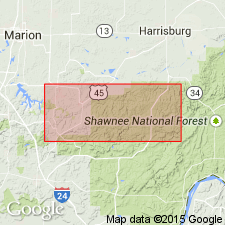
- Usage in publication:
-
- Delwood formation
- Modifications:
-
- Original reference
- Dominant lithology:
-
- Sandstone
- Coal
- AAPG geologic province:
-
- Illinois basin
Summary:
Pg. 16 (table), 39, 40, 41. Delwood formation of Tradewater group. Formation contains only one important sandstone and one coal and is considered to represent a single cycle of deposition. Basal sandstone is about 50 feet thick, generally massive and cross-bedded and conspicuously micaceous; above the coal, formation consists of a succession of sandy shales and shaly to thin-bedded sandstones with a probable maximum thickness of 50 feet. Underlies Macedonia formation; overlies Grindstaff formation. Age is Pennsylvanian.
[Named from Delwood, a crossroads village in northern part of Pope Co., IL.]
Source: US geologic names lexicon (USGS Bull. 1200, p. 1086).

- Usage in publication:
-
- Delwood formation
- Modifications:
-
- Principal reference
- AAPG geologic province:
-
- Illinois basin
Summary:
Pg. 9. Delwood formation in Tradewater group [?Delwood sandstone in Tradewater group]. Type locality designated. Age is Pennsylvanian.
Type locality: in sec. 5, T. 11 S., R. 6 E., Pope Co., southern IL.
Source: US geologic names lexicon (USGS Bull. 1200, p. 1086).

- Usage in publication:
-
- Delwood sandstone†
- Modifications:
-
- Abandoned
- AAPG geologic province:
-
- Illinois basin
Summary:
Pg. 31. †Delwood sandstone abandoned, so that name may be retained for the coal. Replaced with Finnie sandstone member, reallocated to Abbott formation (new) of McCormick group (new).
Source: US geologic names lexicon (USGS Bull. 1200, p. 1086); GNU records (USGS DDS-6; Reston GNULEX).

- Usage in publication:
-
- Delwood
- Modifications:
-
- Not used
- AAPG geologic province:
-
- Illinois basin
Summary:
Nomenclature chart (fig. 10) reveals Murray Bluff Sandstone Member of Abbott Formation of this report referred to as Delwood sandstone by Potter (1957).
Source: GNU records (USGS DDS-6; Reston GNULEX).
For more information, please contact Nancy Stamm, Geologic Names Committee Secretary.
Asterisk (*) indicates published by U.S. Geological Survey authors.
"No current usage" (†) implies that a name has been abandoned or has fallen into disuse. Former usage and, if known, replacement name given in parentheses ( ).
Slash (/) indicates name conflicts with nomenclatural guidelines (CSN, 1933; ACSN, 1961, 1970; NACSN, 1983, 2005, 2021). May be explained within brackets ([ ]).

